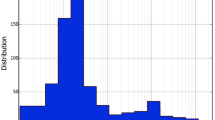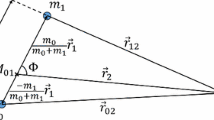Abstract
Numerical simulations are made within the frame of the elliptic planar restricted three-body problem, in order to search if stable orbits exist for planets around one of the two components in double stars. The values taken for the binary's mass ratio and eccentricity correspond to real nearby double and multiple systems; the α Centauri and Sirius systems are investigated here. Large stable planetary orbits, already known to exist through a systematic exploration of the circular model and for the Sun-Jupiter elliptic case, are found to exist around α Centauri A and α Centauri B, as well as around Sirius A, up to distances from each star of the order of more than half the binary's periastron separation. Similar studies for other nearby well-known double and multiple systems will follow.
Similar content being viewed by others
References
Aumann, H.H.: 1985, ‘Protoplanetary material around nearby stars’, inThe search for extraterrestrial life: recent developments, ed. M.Papagiannis (Reidel), pp. 43–50.
Belyaev, N.A., Kresak, L., Pittich, E.M., Pushkarev, A.N.: 1986,Catalogue of short-period comets, Slovak Acad. Sci. Bratislava.
Benest, D.: 1971, ‘Elliptic Restricted Problem for Sun-Jupiter: Existence of Stable Retrograde Satellites at Large Distance.’,Astron. Astrophys.,13,157–160.
Benest, D.: 1974/1975/1976, ‘Effects of the Mass Ratio on the Existence of Retrograde Satellites in the Circular Plane Restricted Problem I/II/III’,Astron. Astrophys.,32,39–46/45,353–363/53,231–236.
Benest, D.: 1979, ‘Derniers Résultats dans l'Etude du Problème Restreint.’, inMécanique Céleste, Astrométric et Géodésie, ed.GS5 (Obs.Bordeaux), p. 23.
Benest, D.: 1982, ‘Les étoiles à portée de la main.’,l'Astronomie,96,500–507.
Benest, D.: 1983, ‘Spectral type distribution in the close solar neighborhood’, inThe nearby stars and the stellar luminosity function, eds. A.G.Davis Philip and A.R.Upgren (L.Davis Press), pp. 25–28
Benest, D.: 1988, ‘Planetary orbits in elliptic restricted problem. I. The α Centauri systems.’,Astron. Astrophys. (submitted).
Dole, S.H.: 1961, ‘Limits for stable near-circular planetary or satellite orbits in the restricted 3-body problem.’,Am. Rocket Soc. J.,31,214–219.
Dole, S.H.: 1970, ‘Computer simulation of the formation of planetary systems.’,Icarus,13,494–508.
Donnison, J.R.: 1984, ‘The mass and position of possible past companions of the Sun.’,Earth Moon Planets,30,107–111.
Dvorak, R.: 1982, ‘Planetenbahnen in Doppelsternsystemen’,Sitz. Österreich. Akad. Wiss., Math.-naturw. Klasse, Abt. II191, 423.
Dvorak, R.: 1984, ‘Numerical experiment on planetary orbits in double stars’,Cel. Mech.,34,369–378.
Dvorak, R.: 1986, ‘Critical orbits in the elliptic restricted three-body problem’,Astron. Astrophys.,167,379–386.
Dvorak, R.: 1988, ‘Orbites critiques dans le problème restreint circulaire et elliptique (orbites planétaires dans des binaires).’, inComptes-Rendus de la Table Ronde de planétologie dynamique, ed. D.Benest (Obs. Nice) (in press).
Dyakov, B.B., Reznikov, B.I.: 1980, ‘Computer simulation of planet formation in binary star systems: terrestrial planets.’,Moon and Planets,23,429–443.
Gatewood, G.D., Gatewood, C.V.: 1978, ‘A study of Sirius’,Ap. J.,225,191–197.
Harrington, R.S.: 1968, ‘Dynamical evolution of triple stars.’,A. J.,73,190–194.
Harrington, R.S.: 1972, ‘Stability criteria for triple stars.’,Cel. Mech.,6,322–327.
Harrington, R.S.: 1977, ‘Planetary orbits in binary stars’,A. J.,82,753–756.
Harrington, R.S.: 1981, ‘Planetary orbits in multiple star systems.’, inLife in the Universe, ed. J.Billingham (M.I.T. Press), pp. 119–123.
Hart, M.H.: 1979, ‘Habitable zones about main sequence stars.’,Icarus,37,351–357.
Hénon, M.: 1966, ‘Exploration numérique du problème restreint III. Masses égales, orbites non périodiques.’,Bull. Astr., Série 3,1,57–79.
Heppenheimer, T.A.: 1974, ‘Outline of planet formation in binary systems’,Icarus,22,436–447.
Heppenheimer, T.A.: 1978, ‘On the formation of planets in binary star systems’,Astron. Astrophys.,65,421–426.
Huang, S.S.: 1973, ‘Extrasolar planetary systems.’,Icarus,18,339–376.
Kanamitsu, O., Hirokawa, M.: 1985, ‘The formation of planetary systems — a simulation on the microcomputer.’,Bull. Fukuoka Univ. Educ.,35(III),113–124.
Kelly, W.D.: 1986, ‘Planetary motion about nearby binary star systems with restricted elliptic 3-body motion.’,J. Astronaut. Sci.,34,189–209.
Paprotny, Z., et al.: 1980/1983/1984, ‘Interstellar travel and communiction bibliography I/II(update 1982)/III(update 1984). (section 05.04: Planets of multiple star systems)’,J. Brit. Interplanet. Soc.,33,201–248/36,311–329/37,502–512.
Pavanini, G.: 1907, ‘Sopra una nuova categoria di soluzioni periodiche nel problema dei 3 corpi.’,Annali di Matematica, Serie III,13,179–202.
Poincaré, H.: 1893,Méthodes Nouvelles de la Mécanique Céleste, Gauthier-Villars
Rabl, G., Dvorak, R.: 1988, ‘Satellite-type planetary orbits in double stars: a numerical approach.’,Astron. Astrophys.,191,385–391.
Rawal, J.J.: 1986, ‘The boundary of the Solar System as set by a hypothetical solar companion.’,Earth Moon Planets,36,211–215.
Schechter, M.: 1984, ‘Planets in binary star systems.’,Sky and Telescope,68,394–395.
Szebehely, V.: 1967,Theory of orbits, Acad. Press N.Y..
Szebehely, V.: 1980, ‘Stability of planetary orbits in binary systems’,Cel. Mech.,22,7–12.
Van den Bos, W.H.: 1960, ‘The orbit of Sirius, ADS 5423’,Journal des Observateurs,43,145–151.
Walbaum, M., Duvent, J.L.: 1983, ‘A la recherche des compagnons invisibles des étoiles proches’,l'Astronomic,97,277–289.
Ziglin, S.L.: 1975, ‘On the secular evolution of planetary orbits in binary star systems.’,Sov. Astr. Lett.,1,194–195.
Author information
Authors and Affiliations
Rights and permissions
About this article
Cite this article
Benest, D. Stable planetary orbits around one component in nearby binary stars. Celestial Mechanics 43, 47–53 (1987). https://doi.org/10.1007/BF01234553
Issue Date:
DOI: https://doi.org/10.1007/BF01234553




